
French postcard by Studio Erving, Paris, no. 696. Photo: Lucasfilm Ltd. Harrison Ford as Han Solo in Star Wars: Episode IV - A New Hope (George Lucas, 1977).

American postcard by Classico San Francisco, no. 105-519. Photo: Lucasfilm Ltd. Carrie Fisher as Princess Leia in Star Wars: Episode IV - A New Hope (George Lucas, 1977).

American postcard by Classico San Francisco, no. 105-062. Photo: Lucasfilm Ltd. Anthony Daniels as C-3PO and Kenny Baker as R2-D2 in Star Wars: Episode IV - A New Hope (George Lucas, 1977).
The Empire Strikes Back (1980)
Three years have passed since Star Wars: Episode IV - A New Hope (George Lucas, 1977). In Star Wars Episode V - The Empire Strikes Back (Irvin Kershner, 1980), Luke Skywalker (Mark Hamill) and Han Solo (Harrison Ford) are now officially members of the Rebels, holed up on the ice planet Hoth.
However, Han is wanted en masse by bounty hunters because of his debt to Jabba the Hutt. Moreover, the Galactic Empire is bent on revenge after the destruction of the Death Star and has launched a massive search for the rebels.
On Hoth, Luke is attacked by a wampa. The latter takes the unconscious Luke to an ice cave, where Luke (having woken up again) cuts off the wampa's arm with his lightsaber and flees outside. At the Rebel Alliance on the same planet, Han notices that Luke is not coming back, and goes looking for him.
While Han is on a quest, Luke sees the ghost of his old teacher Obi-Wan Kenobi (Alec McGuinness). The latter tells him to go to the planet Dagobah to look for Yoda, the last surviving Jedi master. He can train Luke further. Then Obi-Wan's ghost disappears and Han arrives. Luke and Han are rescued by a snow speeder, which takes them back to the Rebel Alliance.
The Rebels face an attack by the Imperial forces and its AT-AT walkers and they are brutally overpowered by the Empire. While Han Solo, Chewbacca (Peter Mayhew), Princess Leia (Carrie Fisher) and C-3PO (Anthony Daniels) escape in the damaged Millennium Falcon. Luke Skywalker travels with R2-D2 (Kenny Baker) to Dagobah in search of Yoda (voice of Frank Oz).
Only with the Jedi Master's help will Luke survive when the Dark Side of the Force beckons him into the ultimate duel with Darth Vader. Luke begins Jedi training with Yoda, while his friends are pursued across the galaxy by Darth Vader (David Prowse and the voice of James Earl Jones) and bounty hunter Boba Fett (Jeremy Bulloch).

Spanish postcard by Memory Card, no. 131. Photo: Lucasfilm LTD. Poster for Star Wars: Episode V - The Empire Strikes Back (Irvin Kershner, 1980).

Vintage postcard, no. 606. Photo: Lucasfilm LTD. Poster for Star Wars: Episode V - The Empire Strikes Back (Irvin Kershner, 1980).

Belgian postcard by Mobistar no. 131. Photo: Lucasfilm LTD., 2000. Poster for Star Wars: Episode V - The Empire Strikes Back (Irvin Kershner, 1980).
A risky move which would later pay off several times over
George Lucas had originally planned to only executive produce and finance Star Wars Episode V - The Empire Strikes Back (1980), leaving the directorial duties in the hands of Irvin Kershner and day-to-day producing duties to Gary Kurtz. Directing Star Wars (1977) had left Lucas exhausted and sick, and he had intended to take time off to start to focus on the expansion of the Lucasfilm company and spending more time with his then-wife Marcia Lucas so that they could start a family and finish construction on Skywalker Ranch.
In order to avoid sharing creative rights, George Lucas decided to avoid using a major studio to finance Star Wars Episode V - The Empire Strikes Back (Irvin Kershner, 1980). Instead, he bankrolled the $18 million production himself, using a combination of his profits from Star Wars (George Lucas, 1977) and a bank loan.
Although the move was risky, it would later pay off several times over. However, when production on The Empire Strikes Back (1980) ran over budget and behind schedule, Lucas had to step in and take a more hands-on role, going on location to oversee filming and even directing portions of the film. A disastrous rough cut of the film proved to be incoherent during screenings, and facing the possibility of financial ruin, Lucas then re-edited the film himself with even worse results.
Extensive re-shoots and further post-production effects work put enormous strain on his health, his marriage, and his relationships with Kershner and Kurtz. To preserve the dramatic opening of the Star Wars films, George Lucas insisted on moving all the credits to the end of the film. However, although the Writers' Guild and Directors' Guild had begrudgingly allowed this on Star Wars (1977) because that film wasn't expected to be very successful, they resented the trend being continued on the sequel.
First, they tried to pull the film from release but were unsuccessful. They then fined Lucas heavily and tried to fine Irvin Kershner, but Lucas paid all of the fines himself (nearly $250,000). Lucas then bitterly dropped his membership in the Writers' Guild, Directors' Guild, and the Motion Picture Association of America, a move that has hindered his hiring choices for later films.

American collectors card by Topps Widevision, no. 4. Photo: Lucasfilm LTD. Mark Hamill as Luke Skywalker in Star Wars: Episode V - The Empire Strikes Back (Irvin Kershner, 1980). Caption: Ext. Plain of Hoth - Pulling off his protective goggles, Luke Skywalker notices something in the sky. He takes a pair of electrobinoculars from his utility belt and through them sees smoke rising from where the probe droid has crashed. The wind whips at Luke's fur-lined cap as he activates a comlink transmitter.
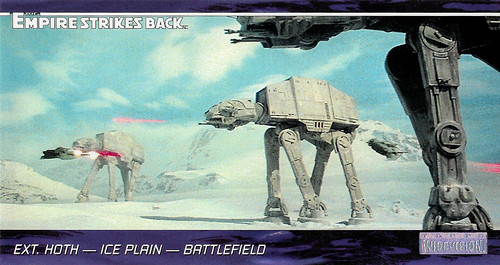
American collectors card by Topps Widevision, no. 24. Photo: Lucasfilm LTD. The AT-AT walkers in Star Wars: Episode V - The Empire Strikes Back (Irvin Kershner, 1980). Caption: Ext. Hoth - Ice plain - Battlefield. The battle on Hoth continues to rage. A giant At-At head swivels and figures, striking a snowspeeder and sending it crashing in a ball of flames. Elsewhere, Rebel troops in the snow french fire on the approaching walkers, as snow and ice explode all around them.

American collectors card by Topps Widevision, no. 68. Photo: Lucasfilm LTD. Yoda (with the voice of Frank Oz) in Star Wars: Episode V - The Empire Strikes Back (Irvin Kershner, 1980). Caption: Ext. Dagobah. Yoda turns to see a huge dead, black tree, its base surrounded by a few feet of water. Giant, twisted roots form a dark and sinister cave on one side. Luke stares at the tree, trembling. "What's in there?" he asks Yoda. "Only what you take with you." Yoda answers.
One of the most expensive films of its day
A new character in Star Wars Episode V - The Empire Strikes Back (1980) was Yoda, originally designed by British make-up artist Stuart Freeborn and voiced by Frank Oz. In the original Star Wars trilogy, he is realised as a puppet, controlled by Oz. The Dagobah set needed to be elevated to give Frank Oz and three other puppeteers room to control the Yoda puppet from below.
For proper interaction, Mark Hamill was given an earpiece so he could hear Oz doing Yoda's voice. On numerous occasions, director Irvin Kershner would give a direction to Yoda by mistake, and Oz would have to remind him who to speak to.
Harrison Ford wanted Han Solo to die at the end of this second film, and he did not want to play the character again. When Star Wars (1977) was made, Carrie Fisher and Mark Hamill were signed for a three-movie deal, but Ford refused since the character had played his part already in the second film.
Instead of killing off the character, George Lucas had a different idea. He opted for Han to be frozen in carbonite, in case Ford had a change of heart and agreed to return in the third film, the character would be revived. And yes, Han Solo still had a heroic part to play in Star Wars: Episode VI - Return of the Jedi (Richard Marquand, 1983).
Lucas recovered his investment within three months of the release of Star Wars Episode V - The Empire Strikes Back (1980). After the various increases in budget, the film became one of the most expensive of its day and after the bank threatened to pull his loan, George Lucas was forced to approach Twentieth Century Fox. Lucas made a deal with the studio to secure the loan in exchange for paying the studio more money but without the loss of his sequel and merchandising rights.
After the film's box-office success, unhappiness at the studio over the deal's generosity to Lucas caused studio president Alan Ladd, Jr. to quit. Lucas, however, showed gratitude far beyond the Hollywood norm by sharing the profits with his employees (nearly $5 million in bonuses). Though the film proved to be an enormous commercial and critical success, George Lucas would never work with Gary Kurtz again, and his marriage with Marcia Lucas dissolved a couple of years later.
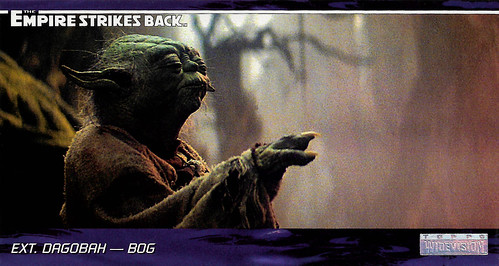
American collectors card by Topps Widevision, no. 78. Photo: Lucasfilm LTD. Yoda (with the voice of Frank Oz) in Star Wars: Episode V - The Empire Strikes Back (Irvin Kershner, 1980). Caption: Ext. Dagobah - Bog. Luke is unable to raise his ship from the bog with his levitation skills. Quietly, Yoda turns towards the sunken x-wing fighter. With his eyes closed, he raises his arm and points at the ship. Soon the fighter rises above the water and moves forward as Artoo beeps in terror and scoots away.

American collectors card by Topps Widevision, no. 106. Photo: Lucasfilm LTD. Billie Dee Williams as Lando in Star Wars Episode: V - The Empire Strikes Back (Irvin Kershner, 1980). Caption: Int. Cloud City - Carbon-freezing chamber. A huge, mechanical tong lifts the steaming, metal-encased Han Solo out of the carbon vat and stands him on the platform. Some Ugnaughts rush over and push the block over onto the platform. They then attach an electric box onto the structure and step away. Lando kneels and adjusts some knobs, measuring the heat. Seeing Han is still alive, Lando shakes his head in relief.

German postcard by Filmwelt Berlin, Bad Münder, no. SW 5.049. Image: Lucasfilm. Publicity still for Star Wars: Episode V - The Empire Strikes Back (Irvin Kershner, 1980).
Star Wars Episode VI - Return of the Jedi (1983)
A long time ago, in a galaxy far, far away..... Star Wars Episode VI - Return of the Jedi (1983) takes place a year after Han Solo has been frozen in carbonite to be transported to crime lord Jabba the Hutt, a large slug-like alien, for a bounty.
Luke Skywalker heads to Dagobah to finish his training with Yoda; however, the Jedi is dying and he confirms that Darth Vader (David Prowse) is his father. Obi-Wan Kenobi's Force spirit later tells Luke that Leia is his twin sister and that he must face Vader again to finish his training and defeat the Empire.
C-3PO and R2-D2 are sent to crime lord Jabba's palace in the desert world of Tatooine in a trade bargain made by Luke Skywalker to rescue Han, who is still frozen. Disguised as the bounty hunter Boushh, Princess Leia sneaks into the palace under the pretence of collecting the bounty on Chewbacca and unfreezes Han but is caught by Jabba and chained to him as his slave.
Luke shows up and after many adventures and fights, Leia strangles Jabba to death with her slave chains and is freed by Luke. Meanwhile, the rebels discover that the Empire is building a new Death Star more powerful than the first one that is protected by an energy shield generated by a generator on planet Endor.
Han Solo and Princess Leia reaffirm their love, and team with Chewbacca, the Ewoks, and droids C-3PO and R2-D2 to aid in the disruption of the Dark Side, and the defeat of the evil emperor. The Rebel Fleet led by Lando Calrissian battles with the Imperial Fleet while they wait for the shields to go down. Luke has a final showdown with Darth Vader. He struggles to help dis father back from the dark side without falling into the Emperor's trap.
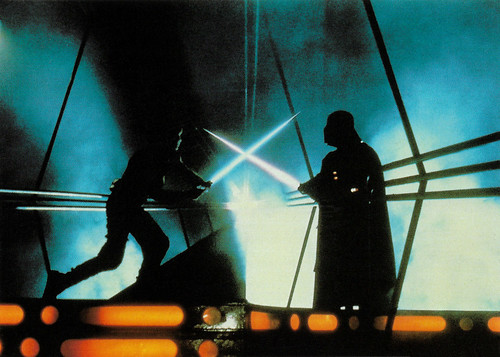
Vintage postcard. Image: Lucasfilm. Mark Hamill and David Prowse in Star Wars: Episode V - The Empire Strikes Back (Irvin Kershner, 1980).
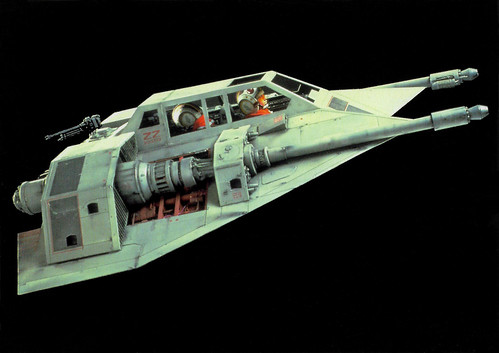
Vintage postcard. Image: Lucasfilm. Publicity still for Star Wars: Episode V - The Empire Strikes Back (Irvin Kershner, 1980).
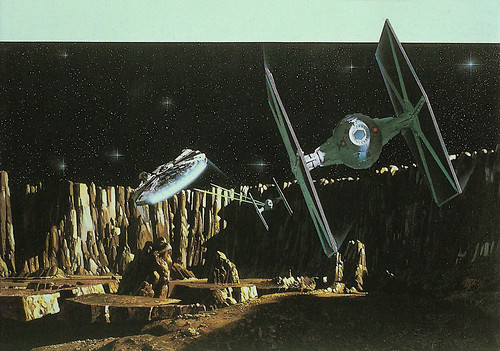
West-German postcard by Filmwelt Berlin, Bad Gmünder, no. SW 5.038. Image: Lucasfilm. Publicity still for Star Wars: Episode V - The Empire Strikes Back (Irvin Kershner, 1980).
Priority on story or spectacle?
Star Wars Episode VI - Return of the Jedi (Richard Marquand, 1983) is action-packed with a tremendous triple battle at the end. The final lightsaber battle between Vader and Luke is breathtaking. The beautiful ending of the film brings everything together.
Still, the film was generally seen as a step down from its two predecessors. The comic and romantic elements weren't as developed. The furry Ewoks are a bit too cute. In other scenes, the film seems to take itself too seriously.
Luke A. McGowan at IMDb: "It is full of holes, tonal inconsistencies and plot implausibilities. I'd chalk this up to Richard Marquand not being half as competent as Irvin Kershner, and the departure of Gary Kurtz from the project. Kurtz reportedly left because he and Lucas couldn't agree on whether story or spectacle should take priority."
Derek Armstrong at AllMovie: "Overrun by furry Ewoks, the sixth episode in the planned nine-part story represented George Lucas' turn toward kiddie sensibilities, which he would continue in force with the much-reviled Jar Jar Binks character in Star Wars, Episode I: The Phantom Menace. Still, with C3PO constantly getting himself into slapstick jams that inspired endless doomsday whining, the saga had always included silly bursts of comic relief, and the Ewoks only furthered that trend."
However, the plot of Return of the Jedi is still fast-paced and sophisticated and the film is still enormously entertaining, thanks to the elaborate set pieces and the well-choreographed battles. And John Williams's music remains a brilliant and innovative film score.
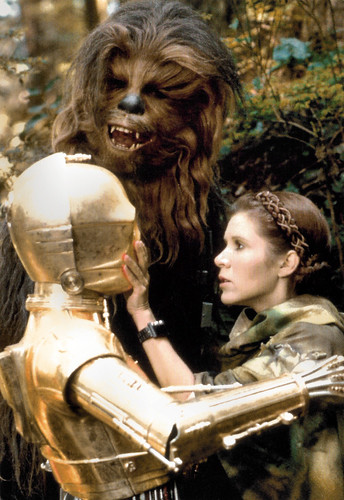
American postcard by Classico San Francisco, no. 105-531. Photo: Lucasfilm Ltd. Anthony Daniels as C3-PO, Peter Mayhew as Chewbacca and Carrie Fisher as Princess Leia in Star Wars: Episode VI - Return of the Jedi (George Lucas, 1983).
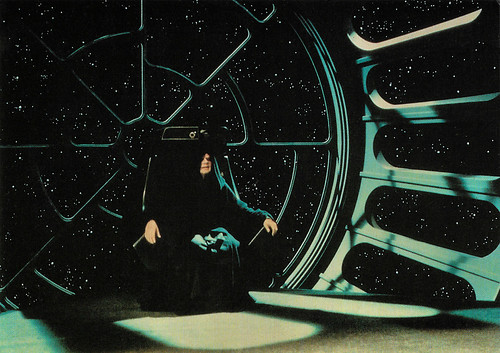
German postcard by Filmwelt Berlin, Bad Münder, no. SW 6.029. Photo: Lucasfilm Ltd. Ian McDiarmid as The Emperor in Star Wars: Episode VI - Return of the Jedi (Richard Marquand, 1983).

British autograph card. Photo: Alec Guinness in Star Wars (George Lucas, 1977).
Sources: Luke A. McGowan (IMDb), Derek Armstrong (AllMovie), Wikipedia and IMDb.
No comments:
Post a Comment